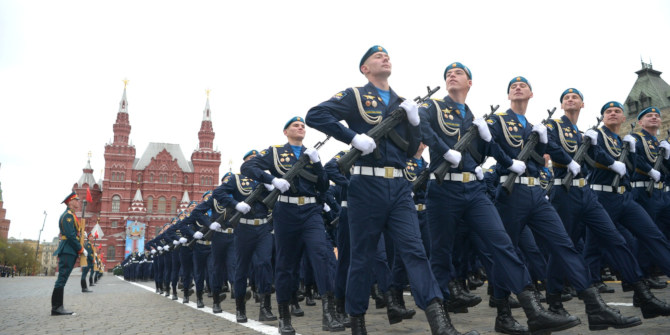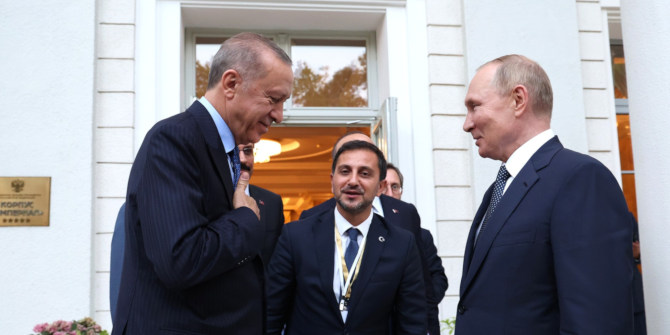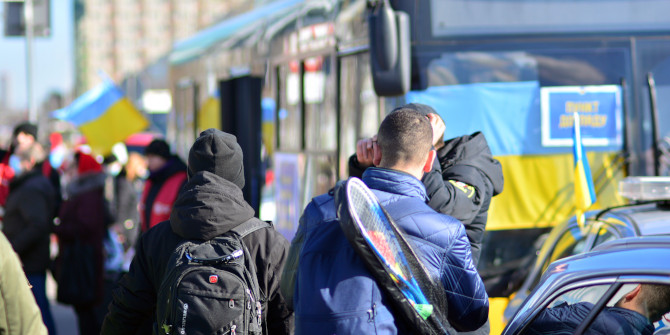Russia’s attempted annexation of four Ukrainian regions following hastily organised ‘referendums’ has been heavily criticised by politicians in the West. Eleanor Knott argues the votes were not only illegitimate but have also further undermined Russia’s claim over Crimea.
In 2014, annexation – the forcible seizure of a state’s territory by another state – was a rarity. After all, annexation is an internationally illegal and “morally impermissible” act. Before Russia’s annexation of Crimea in 2014, the last previous example –Morocco’s occupation of Western Sahara – was in 1976.
In late September 2022, Russia set about annexing four further regions of Ukraine: Donetsk, Luhansk, Zaporizhzhia, and Kherson. Like in Crimea, Russia organised illegal and sham annexation ‘referendums’ in the four regions. Against the backdrop of ongoing shelling and Russian occupation, ‘voting’ in the ‘referendums’ took place between 23 and 27 September, with annexation treaties signed by Russia on 30 September 2022.
These are not referendums
Like with Crimea, these were far from legitimate referendums. They were neither free nor fair. They were not held with neutral international observers and they took place in the context of an ongoing war, invasion, and occupation launched by Russia on the territory of Ukraine.
Searching for an alternative word than ‘referendum’ to explain what is going on, Tim Snyder labels them instead as “media exercises”. For Snyder, these media exercises are part of a propaganda campaign “to shape how people think about Russian-occupied Ukraine”.
Labelling the ‘referendums’ simply as “illegal”, we might “convince ourselves that some voting happened with some flaws” when “meaningful voting” was neither possible nor occurred. These exercises are designed to create facts on the ground to match Putin’s intentions to annex these four territories. There was never an alternative plan but ‘referendums’ that led Russia to annex Donetsk, Luhansk, Zaporizhzhia, and Kherson.
Revisiting Crimea
The ‘referendums’ in these four regions in 2022 should encourage us to revisit what we know, or what we think we know about a similar annexation ‘referendum’ held by Russia in Crimea in 2014. It should also encourage us to revisit what we think we know about Crimea’s residents’ identity and preferences in the run up to Russia’s annexation.
Few recognise the results of the 2022 ‘referendums’ as representing the real preferences of these regions’ residents. In Crimea, we also recognise that the 2014 referendum was illegal, illegitimate, neither free nor fair, and held in conditions of an armed occupation. But, many suggest that the outcome of the referendum – where a majority voted in support of annexation – is still how a majority would have voted if the referendum was held under free and fair conditions. After all, weren’t the majority of Crimea’s residents already pro-Russian nationalists? Weren’t they already Russian citizens?
My recently published book, Kin Majorities, questions all these assumptions. Based on fieldwork prior to annexation, in 2012 and 2013, I show how Russian identification was far more complex in Crimea than we previously understood or recognised. Crimea is often presented as a region inhabited by a majority of ethnic Russians. In fact, the 2001 census shows that only a small majority (58%) identified as ethnically Russian.
Identifying as ethnically Russian, or speaking Russian, did not mean wanting to engage or aligning with, or support, Russia, especially the Putin regime. Put simply, identifying as ethnically Russian did not translate into being a Russian nationalist, or being pro-Russian, for many. Moreover, many I interviewed did not view Russia as a positive entity, but as corrupt and authoritarian, and more corrupt and far more authoritarian than Ukraine.
Moreover, a large constituency of those interviewed eschewed talking in ethnic terms altogether. They might identify their parents as ethnically Russian, and they might speak Russian, but they identified first and foremost as Ukrainian citizens. Attachment to Ukraine, as their state, was their preferred way of identifying.
We also need to revisit whether Crimea was ‘passportised’ before Russian annexation, which is to say whether individuals had really acquired Russian citizenship en masse before 2014. In my book, I detail how I never met anyone with Russian citizenship, and interviewed very few who wanted Russian citizenship. For most, Russian citizenship was neither available nor desirable, giving Crimea’s residents rights they neither wanted nor needed.
In turn, we should not just assume that the preferences of Crimea’s residents were so simply pro-Russian before Russia’s annexation. Doing so accepts Russia’s version of events. Rather, we should continue to be sceptical both about the legitimacy of the annexation ‘referendum’ and its result, just as we are of the annexation ‘referendums’ that took place in 2022.
Key differences
As much as they are similar, the 2014 ‘referendum’ in Crimea is also different in two ways to the 2022 ‘referendums’. First, Russia had total political and military control in Crimea prior to the ‘referendum’ after Ukraine ordered its military to retreat. Ukraine was, understandably, concerned that they risked escalation with Russia – such as an invasion of the mainland of Ukraine – if they installed martial law. Instead, Ukraine did not order troops stationed in Crimea to actively resist. Crimea has remained under Russia’s de facto control since March 2014.
In contrast, Russia does not control, politically or militarily, by any means the entire territory of the four regions it has sought to annex. Ukraine is gaining significant ground in these territories, in Kherson particularly. The scenes from liberated towns, of people emotionally greeting Ukrainian troops liberating them from Russian occupation demonstrate how far Russia is away from securing the successful annexation of these territories.
Second, the nature of the conflict differs. Zaporizhzhia, Kherson, Donetsk, and Luhansk are all active sites of war, invasion, and occupation. But, in Crimea, Ukrainian troops withdrew before fighting ensued. There was little overt violence during annexation and only one death.
Today’s violence in Crimea is a consequence of annexation. Russia has sought to punish, persecute, kidnap, torture, and murder those who disagree with annexation, or demonstrate active support for Ukraine since 2014. Crimean Tatars have been particular victims of these human rights abuses, and labelled as extremist, had their rights restricted, and their organisations banned.
Just as Russia drafted reservists to serve in its war against Ukraine, and hundreds of thousands have fled Russia, it has specifically targeted Crimean Tatars with draft notices. These actions follow Russia’s actions elsewhere in disproportionately targeting regions of Russia with high non-Russian minorities, and Muslim minorities in particular. Refat Chubarov, the leader of the Crimean Tatar national movement, has argued that Russia’s draft notices aim to demobilise and “destroy as much as they can of the adult Crimean Tatar population”, given they constitute the biggest internal opponents of Putin’s annexation of Crimea.
Remembering Crimea
If there is one takeaway from the illegal ‘referendums’ held in four of Ukraine’s regions then it should be the implications for Crimea’s referendum. Some have branded these annexations a “strategic mistake” by devaluing and undermining Russia’s annexation of Crimea. Indeed, Russia’s annexation of Crimea was supposed to be a “special” case. Now Russia is acting as if it is a path we should expect the country to take.
Politicians and policymakers in the West do not accept the 2022 annexations by Russia and regard the accompanying ‘referendums’ as illegitimate. While they do not officially accept Russia’s annexation of Crimea, many have tacitly accepted it as an unfortunate reality. Yet, if we acknowledge the 2022 annexation ‘referendums’ not only as illegal and shambolic but “obscene”, why should we think any differently of Russia’s annexation of Crimea?
We do not know how Crimea’s residents would have voted in a free and fair referendum. We should accept it no more than Russia’s annexation of Kherson, Zaporizhzhia, Donetsk, and Luhansk.
Note: This article gives the views of the author, not the position of EUROPP – European Politics and Policy or the London School of Economics. Featured image credit: TASS / Kremlin.ru





